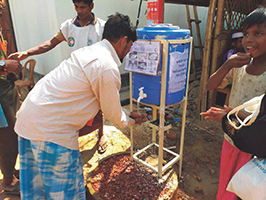Stories from the Field 4Public nomination
Response to COVID-19 at the World’s Largest Camp for Displaced Persons
—UNHCR activities—

A displaced person washing his hands at a handwashing station, installed to help combat the spread of COVID-19 (Photo: UNHCR)

Displaced children with Ms. Hosoi from UNHCR Bangladesh’s Dhaka Office (Photo: UNHCR)
In August 2017, an outbreak of violent clashes in Rakhine state, Myanmar forced hundreds of thousands of people to flee within a matter of days to Cox’s Bazar in the southeastern part of Bangladesh. In order to protect the lives and livelihoods of displaced persons, who were forced to flee their homes with nothing but the clothes on their backs, the Office of the United Nations High Commissioner for Refugees (UNHCR) has been closely collaborating and cooperating with the Government of Bangladesh, partner organizations, and NGOs to develop infrastructure, provide shelter, and deliver emergency relief supplies including food and water.
Three years have passed since the incident in Myanmar, yet the road to repatriation has not been easy for those forcibly displaced. Displaced persons continue to face various challenges each day in settlements across Cox’s Bazar, and the global spread of COVID-19 since the beginning of 2020 has further intensified existing hardships.
Approximately 860,000 displaced persons have fled to Cox’s Bazar,* currently living in shelters across more than 30 settlements. Cox’s Bazar is one of the poorest regions in Bangladesh, and the risk of infection by COVID-19 is heightened by the lack of adequate medical services and sanitation in the densely populated camps.
Since the beginning of the pandemic, UNHCR has been working on COVID-19 infection prevention and control measures in the camps. As a major donor country, Japan has also contributed greatly, mainly in the following two areas.
The first is in the establishment of health care facilities and provision of medical supplies. With financial contributions from the Government of Japan, UNHCR has provided isolation facilities for treating patients, medical equipment, personal protective equipment (PPE), and other supplies required in intensive care units (ICU). COVID-19 response mechanisms were established at an early stage through support from Japan and other countries, which contributed to promptly provide appropriate treatment when the first case of COVID-19 infection in Cox’s Bazar was confirmed in May.
The second is in the improvement of hygiene and sanitation conditions at the camps. Good sanitation is essential in preventing the spread of infectious diseases. UNHCR has worked to provide improved latrines, shower facilities, and waste management systems to reduce the risk of infection. As a preparation for the impending monsoon rains, these measures have also been effective in preventing water-borne infectious diseases, such as cholera.
However, none of these efforts would be possible without the presence of aid workers dedicated to delivering humanitarian assistance on the ground. Among these aid workers are a large number of Japanese nationals who work for international organizations, such as UNHCR and NGOs. “Unease and fear. That is exactly what we felt at the beginning of the COVID-19 crisis,” recalls Ms. HOSOI Mai from UNHCR Bangladesh. She says that while UNHCR has worked tirelessly to strengthen health and sanitation infrastructure, volunteers from among the displaced persons have played a vital role in these efforts. “Displaced persons have taken matters into their own hands to protect their own lives, and as volunteers, help raise awareness to prevent the spread of COVID-19. Seeing their self-reliance and resilience despite having been beset by numerous challenges in the camps gives me a great deal of courage,” states Ms. Hosoi, adding, “my hope is for the people of Japan to show compassion towards, and recognize the strength of, those forced to flee their homes.”
*Source: UNHCR Bangladesh, Operational Update External, November 2020 https://data2.unhcr.org/en/documents/details/83629
<< Previous Page Next Page >>
Main Text | Reference Statistics | Reference Materials | Stories from the Field | Master Techniques from Japan to the World | ODA Topics
